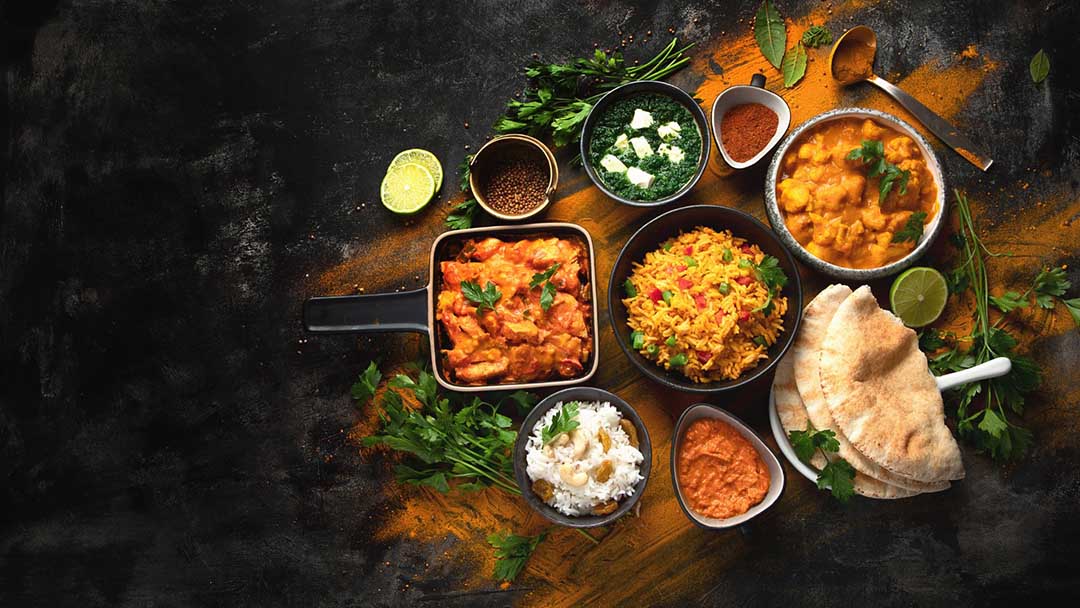Introduction to the Diverse Culinary Landscape of India
Indian cuisine, with its splendid mosaic of flavours, aromas, and textures, is one of the world’s most diverse culinary landscapes. This richness is rooted not only in India’s vast history, incorporating various cultural influences, but also in the immense geographical diversity of the subcontinent. From the snow-clad peaks of the Himalayas to the tropical shores of Kerala, and from the fertile plains of Punjab to the dense forests of Bengal, every region boasts its own unique culinary traditions.
1. Northern Flavours
Beginning our journey in the North, the state of Punjab is often seen as the breadbasket of India. The food here is hearty and robust, characterised by wheat-based dishes like parathas and naans. One cannot discuss Punjabi cuisine without mentioning the globally popular ‘Butter Chicken’ or its vegetarian counterpart, ‘Paneer Makhani’. These dishes are rich and creamy, often cooked with generous amounts of butter and cream.
Further up North, in Kashmir, the cuisine becomes even more elaborate. Wazwan, a multi-course meal, showcases the culinary depth of Kashmir. It includes dishes like Rogan Josh (a spicy lamb curry) and Yakhni (yogurt-based mutton curry).
2. Western Delicacies
As we move westward, the state of Rajasthan presents a cuisine that has evolved in response to both its arid conditions and royal heritage. The lack of fresh vegetables has given rise to dishes like ‘Ker Sangri’ (a preparation of dried berries and beans) and ‘Bajra roti’ (pearl millet flatbread). The royal kitchens, meanwhile, have bestowed dishes like ‘Laal Maas’ (spicy mutton curry) upon the culinary repertoire.
Neighbouring Gujarat, on the other hand, offers a predominantly vegetarian cuisine with a hint of sweetness in almost every dish. ‘Dhokla’ (steamed rice and chickpea cake) and ‘Khandvi’ (rolled snacks made of chickpea flour) are popular snacks here.
3. Eastern Specialities
Journeying east, West Bengal brings forth a cuisine centred around fish, rice, and sweets. ‘Hilsa’ fish curry, or ‘Shorshe Ilish’, made with mustard seeds, is a regional delicacy. Bengal’s sweet offerings, including ‘Rasgulla’, ‘Sandesh’, and ‘Mishti Doi’ (sweetened yogurt), are renowned across India.
Odisha, Bengal’s southern neighbour, also offers dishes like ‘Dalma’ (lentils cooked with vegetables) and the sweet ‘Chhena Poda’ (burnt cheese dessert).
4. Southern Delights
Heading down to the Southern peninsula, four states dominate the culinary scene: Andhra Pradesh, Karnataka, Tamil Nadu, and Kerala.
Andhra cuisine is fiery, with dishes like ‘Gongura Pickle’ (sorrel leaves pickle) and ‘Hyderabadi Biryani’ (a spicy rice dish with meat). Karnataka, especially its Udupi region, is known for its vegetarian fare like ‘Masala Dosa’ (rice and lentil pancake with a spicy potato filling) and ‘Bisi Bele Bath’ (rice, lentils, and vegetables cooked together with spices).
Tamil Nadu offers ‘Chettinad Chicken’, a spicy chicken preparation, as well as a range of rice-based dishes like ‘Lemon Rice’ and ‘Pongal’. Kerala, the ‘land of spices’, offers ‘Sadya’, a vegetarian feast served on banana leaves, and seafood dishes like ‘Kerala Prawn Curry’.
5. The North-Eastern Frontier
The seven sisters, as the North-Eastern states are often called, present a markedly different palette. Ingredients like bamboo shoot, fermented soybean, and smoked pork dominate the scene. Nagaland’s ‘Smoked Pork with Bamboo Shoot’ and Assam’s ‘Masor Tenga’ (sour fish curry) are notable dishes from this region.
6. Central India and the Deccan Plateau
Central India, encompassing states like Madhya Pradesh and Chhattisgarh, often goes unnoticed in culinary discussions. Yet, it brings forth rustic dishes like ‘Bhutte ka Kees’ (grated corn cooked with spices) and ‘Chana Samosa’ (samosas filled with spicy chickpeas).
The Deccan region, including Maharashtra, has its own jewels like ‘Poha’ (flattened rice breakfast dish) and ‘Puran Poli’ (sweet lentil-stuffed bread).
Conclusion
India’s culinary diversity is a testament to its rich cultural tapestry and varied geographical terrains. Each state, each region, and often each community within these regions, boasts its own unique dishes, preparation methods, and flavour profiles.
Whether it’s the royal delicacies from the kitchens of Rajasthan, the fiery dishes of Andhra, the sweetmeats of Bengal, or the earthy flavours of the North-East, Indian cuisine is a delightful journey of taste, traditions, and tales. Just as India is a subcontinent of diverse cultures, languages, and landscapes, its cuisine is a world in its own right, waiting to be explored and savoured.
Subscribe




